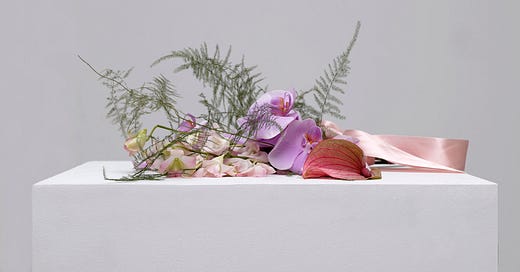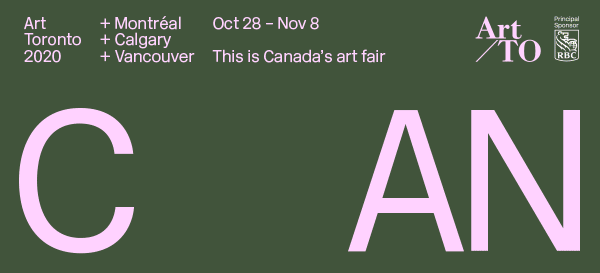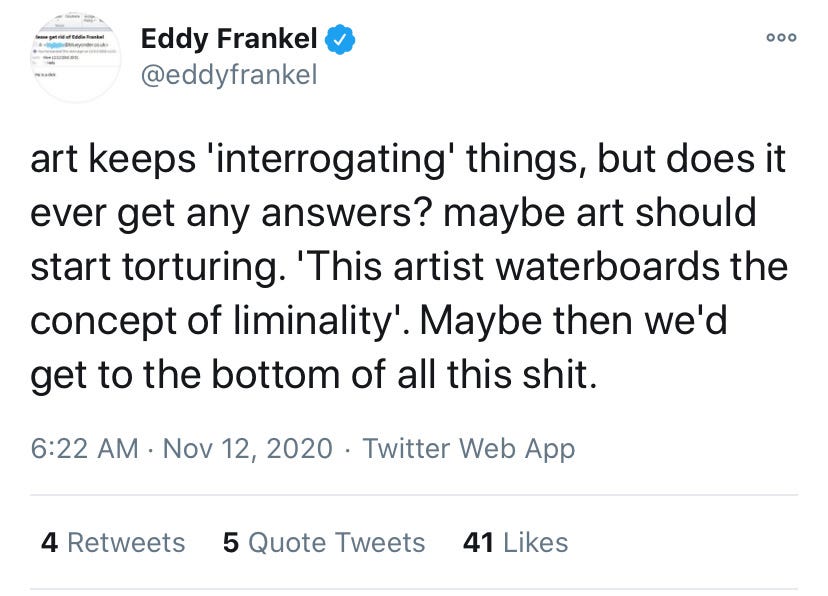In The Work of Art in the Age of Mechanical Reproduction, Walter Benjamin lamented the loss of an artwork’s aura when reproduced. There’s an energy to standing in front of a work of art, according to Benjamin, that is cultivated by the history of the artist’s touch on the canvas. While a reproduction, or print, can capture the logistical aspects of art (colour, composition, size), it lacks the excitement of seeing the original in person.
I was surprised that the same was true with art fairs. Translated online, the chaotic energy and excitement of walking around an art fair fade to another online shopping experience. Even with art fair’s best efforts of translating the gallery-hopping event digitally, the best parts of a fair—seeing art in person, talking to people you know, learning about a gallery’s programming—simply don’t compute. The downfalls of fairs, sensory overload and fatigue, do.
Art Toronto’s annual fair wrapped up last week. I loved the combination of online and physical events. In Toronto, I stopped by the multi-booth pop-up at Stephen Bulger Gallery—which included WAAP, PFOAC, Trepanier-Baer and Michael Gibson—backroom mock-booths at Daniel Faria and Dianna Witte Gallery, a second gallery space at United Contemporary, and a selection of art fair-picks at Clint Roenisch. All had incredibly strong booths, and it was nice to see these mini-group-shows alongside the galleries other exhibitions.
I only attended two online events: my own interview with Keiran Brennan Hinton for Michael Gibson Gallery, and a gallery tour, also with Michael Gibson. My Zoom-fatigue left me mostly disinterested in attending more—though there were some great offerings.
But on a whole, the online fair left me feeling empty. The user experience design of the platform was labyrinth-like and dull—the platform would be better suited to selling dental tools than art. Arranged in grids, the art was flattened to every other online shopping experience. Chatting with gallerists, most noted that any sales they made went to pre-existing clients, the online fair not reaching new collectors in the same way the IRL one does.
The feeling is shared, Art Basel’s Art Market Mid-Year Survey found that only one-third of collectors had made purchases at online fairs and third-party platforms in 2020. An ArtNet article headline reads, “Dealers Report Only a Smattering of Sales at Art Basel and TEFAF’s Online Art Fairs, Raising Doubts About the Value of the Virtual Events.”
Lest I come across as too negative, I will say that the component I most like about online fairs is the posted prices. While galleries have long hidden the prices from the general public (as a way to preserve intrigue and control prices), having prices listed allows more transparency and gives first-time collectors more confidence in reaching out to purchase art. “Most (81%) of the collectors surveyed felt it was important or essential to have a price posted when they were browsing through works of art for sale online,” the Art-Market Mid-Year Survey reports. I’m reminded of the saying “if you have to ask, you can’t afford it.” Now, at least you don’t have to ask to find out if a piece is outside your budget.
If buying online is a pandemic-born necessity, the art world will find a way to adapt to this “new reality.” What that might look like is a medium that fits the message. In other words, a more interestingly designed webpage that cradles the art with the respect it deserves, rather than placing it in a context void of creativity. A good example of this, though at times confusing, is Artissima. I like the focus on one artist per gallery, which makes it feel more intentional and less of an inventory sale.
At the end of the day, online art fairs will never replicate the real thing. And that’s okay. What’s important is that galleries continue to put work forward, and people continue to be invested in art. What that will look like is yet to be seen. What I’m really missing is the conversation and connecting that art fairs bring. Online art shopping can feel a bit like giving up on that , like abandoning the thing I love about collecting: the people I buy from.
What did you think of the art fair? Did you buy anything? Sell anything? Comment below ↓↓↓
LINKS+NEWS
Brantford-raised, Kapwani Kiwanga, artist wins France's top art prize brantford expositor
"Kapwani Kiwanga received the 2020 Marcel Duchamp Prize, along with a $41,000 cash award, for her sculptural series, Flowers for Africa, centred on the presence of flowers at diplomatic events celebrating the independence of African nations.”
Winner - Kapwani Kiwanga - The 2018 Sobey Art Award national gallery of canada
Learn more about Kiwanga’s work and process in this video, published after her 2018 Sobery Art Award.
Ociciwan Opens in Edmonton galleries west
After multiple road blocks, including the pandemic and a break-in, Ociciwan, an Indigenous-run art space, opens its first show.
A Pledge to Help Artists Becomes a Lucrative Lifeline nytimes
““It was set up as a survival mechanism,” said Mr. Burrows. “It turned out they weren’t just surviving on it, they were thriving.” Some were making “double or triple what they were before,” he added.”
Drawn and Quarterly to publish Library by Michael Dumontier and Neil Farber
The book will come out Fall 2021.
Lynne Tillman on How Feminism Has Affected Men another mag
“The difference between wanting to be a writer and actually writing is a world apart, and the determination to do it, and then executing that, took everything I had in me. ”
Interchanges by Winnie Truong the bentway
The projection-based work will be on exhibit from Wednesday, November 18 through to Saturday, November 21 from 6-9pm each evening at Canada Post’s South-Central Letter Processing Plant.
“If I find myself there again,” by Jalil the letter bet
Art deal! “If I find myself there again” by Jalil explores the relationship between the non-natural and natural objects within the piece. The eye-spy composition that mixes ephemera and permanence would make a great holiday gift (at only $90).
Something to think about:






